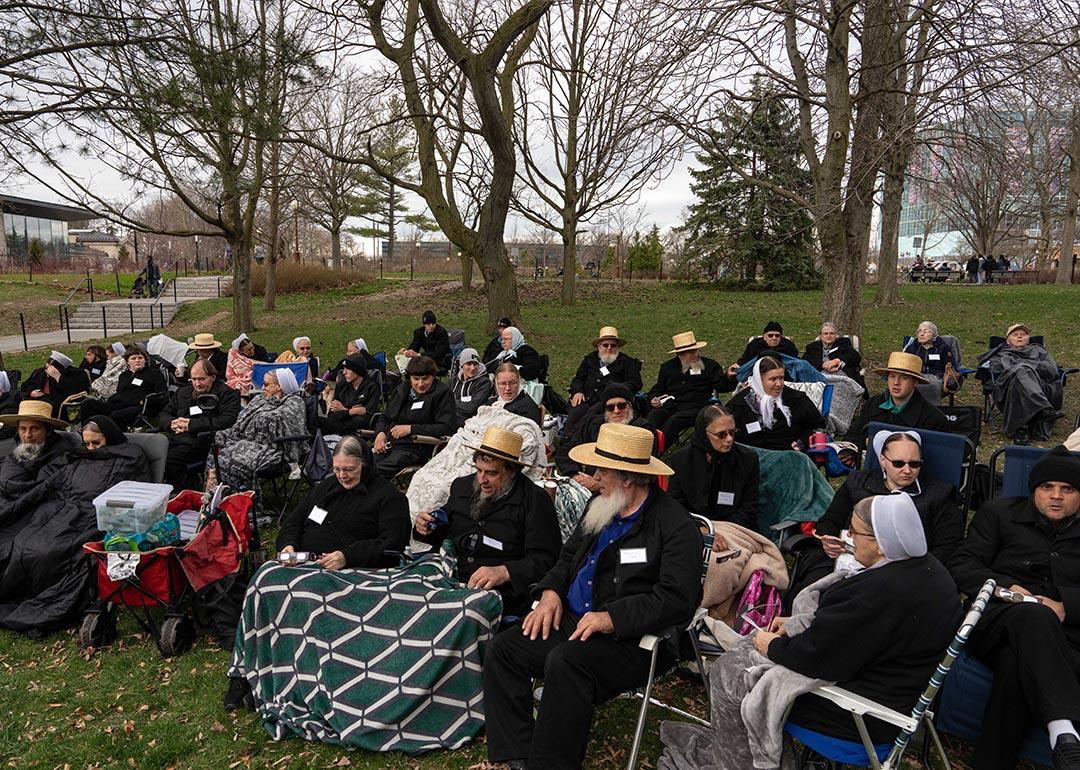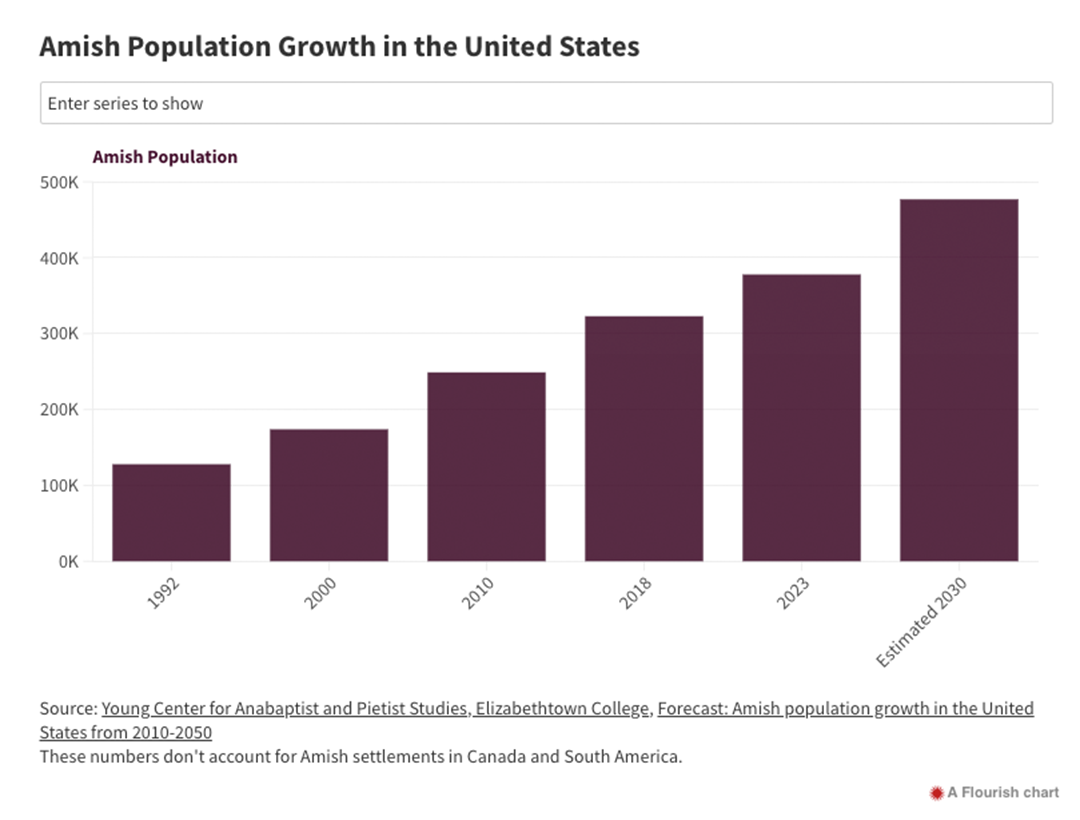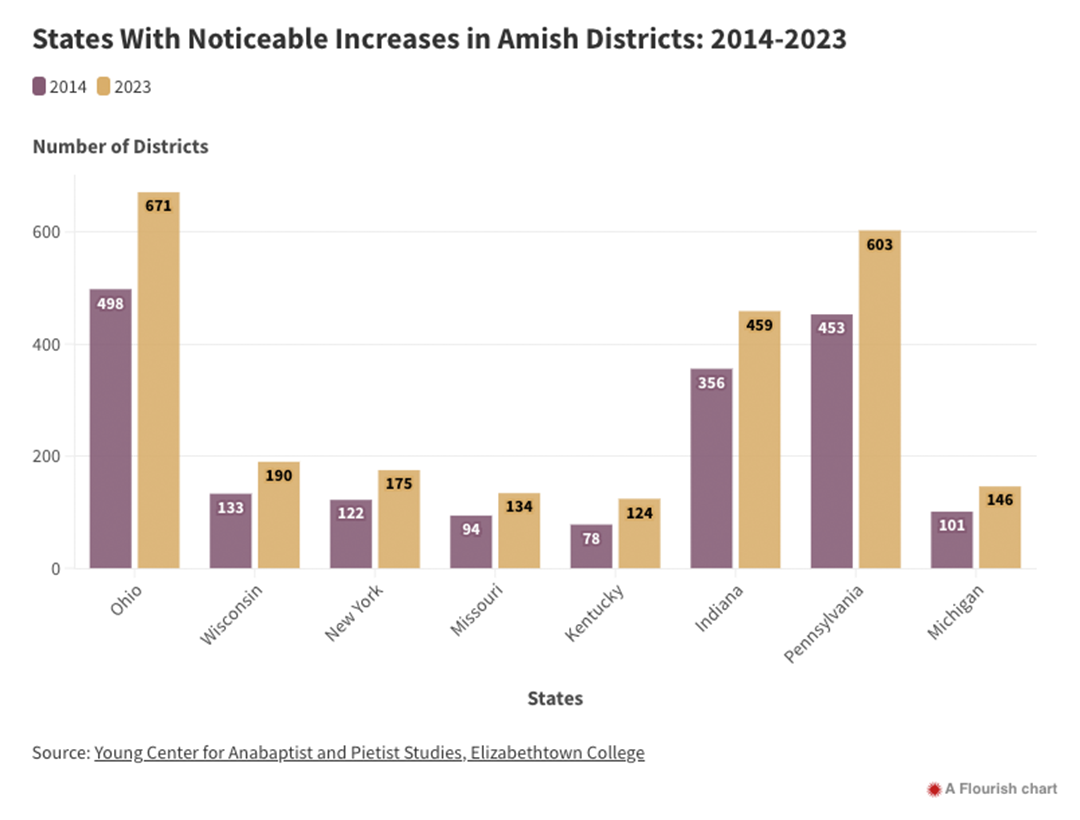
Across the country, Amish populations are on the rise
This story was produced by The Daily Yonder and reviewed and distributed by Stacker Media.
Across the country, Amish populations are on the rise
The Amish, a religious group living almost exclusively in rural America due to their agrarian lifestyle, have astounded both their rural neighbors and researchers with recent population growth.
According to the Young Center for Anabaptist and Pietist Studies at Elizabethtown College, the estimated population of North American Amish in 2023 was 384,290 (6,100 in Canada), a 116% increase from 2000. Statistics show that the population nearly doubles every 20 years.
The Daily Yonder reports that unlike some other Christian denominations, Amish communities don't focus on converting outsiders (there are only a few dozen converts on record), so this population growth comes almost exclusively from existing communities.
"There are two explanatory factors: one is large families, and the second is high retention rates," said Professor Steven Nolt, Director and Senior Scholar at the Young Center for Anabaptist and Pietist Studies at Elizabethtown College. "If you looked at the 1930s, up through about 2000, the retention rate had actually increased. There's a case study that showed that the retention rate went from the upper 70 percent to 90 percent," he said.
While every Amish community has its own practices and beliefs, birth control and abortion are widely frowned upon, a factor contributing to large families. Depending on the community, it's common for families to have six to nine children. In Lancaster County, Pennsylvania — which has the largest Amish population in the world — 10% of Amish families have 10 or more children. This starkly contrasts with the average American family, which has only 1.9 children.

A Growing Population Requires More Land
A community relying on agriculture inherently requires land — and the Amish have shown they are willing to travel to acquire it.
"There were farms being farmed by 70, sometimes 80-year-old, non-Amish farmers. None of their children wanted to farm — it wasn't clear what the future was," said Nolt. "And there were Amish people here in Lancaster … who were looking for land, and they were in touch with agricultural realtors who had their fingers out across the country and said, 'Hey, there's a place in Indiana where it seems like there's a bunch of land for sale.'" States like Indiana have always been a popular destination for Amish families, but circumstances like this have grown the state's population even further.
Amish families aren't just moving to Indiana though. Since 2000, settlements have popped up in six new states: Colorado, Nebraska, New Mexico, South Dakota, Vermont, and Wyoming. In addition to these new states, Minnesota's Amish population has increased by 230% in the last 20 years. In New York, it has more than quadrupled since 2000, growing from 4,505 to an estimated 21,230 people.
According to Nolt, when several Amish families move to a new area, it isn't long until others join them.
"Amish people are a communal culture. Amish families don't just strike out on their own as an individual household … They're not a commune, but they are communal in the sense that they always live in some proximity to other Amish people. So, if starting a new settlement, there might be one family that's going to arrive maybe a few weeks or a few months before everyone else. They're always moving in groups. When you're moving in groups, and every household needs a certain amount of land, that does suggest that you are looking for places where there might be a certain amount," he said.

Getting to Know New Rural Neighbors
An example of this can be seen in Brownington, Vermont. Browinington is part of Vermont's Northeast Kingdom, a nickname given to the state's Northeast counties (Caledonia, Essex, and Orleans) that are sparsely populated and cover over 2,000 square miles. The area is popular with tourists for its scenic hiking and camping destinations. It is also ideal farmland.
Originally reported by the Boston Globe, this small town 30 minutes from the Canadian border saw several Amish families relocate there in 2013.
"They had been contacting us through letters over the years, but nobody had ever shown up," said Daniel Maclure, Owner of Century 21 Farm & Forest, a local real estate company. That changed in November 2013, when Maclure received a phone call from an Amish leader saying that Amish families from Ohio and Pennsylvania were in the area and wanted to view some property.
"I met him at the Sunoco Mini Mart in Orleans. And they [the Amish] were in a bus … they decided that because it was already getting dark, they'd wait till the next day to look at properties. I asked them where they were going to be staying, and they said, 'Well, we brought tents and sleeping bags.'"
While they planned on camping out in a local field or barn in 20-degree weather, Maclure invited the dozen Amish travelers to spend the night at his house. The next day, Maclure and the Amish checked out several properties.
It's been over a decade since the first Amish community settled in Vermont, and they seem to be thriving in their new home. "When they first started coming, a lot of the sons would work at a sawmill. The majority of them working away from home are doing construction, mainly roof siding," Maclure stated.
"There are also a couple of cabinet makers. There's one that makes lawn furniture. Another family has a sawmill. Another one builds garden sheds. And there's even one that started manufacturing steel roofing and steel siding. So yeah, they're pretty talented when it comes to finding things to do and doing a good job at it."
The skilled craftsmanship of the Amish, their hospitality, and admirable work ethic have awarded them the respect of their rural neighbors and the status of key community members. Someone visiting Brownington in the summer can find plenty of Amish baked goods and handmade quilts at local fundraisers and farmer's markets. They also gained the respect of locals by reviving dilapidated barns and houses that were once eyesores scattered across the otherwise verdant, picturesque countryside.
Maclure has become something of a liaison between the Amish and the locals."People call me and say, 'How do I get a hold of these folks?' I said, 'Well, on a Saturday, go up and see them. Don't bother them on a Sunday,'" he added.
Even though farming is still a large part of Amish culture, it's not the only reason they're moving. As Nolt and other researchers point out, the Amish have pivoted to other professions like construction, woodworking, blacksmithing, and starting small businesses.
"Not all the Amish who moved wanted to farm," said Nolt. "In fact, they rapidly subdivided some of the farms that they bought into five-acre parcels. And you had Amish people who were going to start a woodshop, a retail store, or a blacksmith shop. But they wanted five acres because they wanted to have a horse pasture. They wanted to have a small barn. In addition to building a house, they wanted to have a large garden."
In the mid- to late-twentieth century, it was still common for up to 90% of Amish men in a community to farm. Now, according to Nolt, only a third of men under 65 farm.
Keeping Amish Communities Healthy
An increasing Amish population requires increased resources beyond land. One of the most important is healthcare.
Forty miles outside of Cleveland, Ohio, Geauga County has been a hub for Amish settlements since the 1880s — boasting the fourth-largest Amish population in the world. It's also home to some of the rarest genetic diseases in the world. Cohen syndrome, a genetic disorder with only about 1,000 cases worldwide, has multiple cases among the local Amish population.
Some Amish choose not to marry outside their immediate community. Referred to as the Founder Effect, this practice of intermarriage with people of common ancestry for multiple generations creates a limited gene pool, making these communities susceptible to metabolic and genetic disorders.
"In 1998, there were a couple of families from the area […] they all had something in common: they all had children that didn't have a diagnosis, but there was some kind of ailment," said Eli Miller, Executive Director for the DDC Clinic for Special Needs Children in Middlefield, Ohio, a nonprofit clinic helping families in the area dealing with rare genetic disorders.
After reading an article in Reader's Digest, these families, who lived in the Geauga settlement, traveled to visit Dr. Holmes Morton, who had opened a clinic in Lancaster, Pennsylvania, helping Amish with rare genetic disorders.
"The conclusion was, at the end of those two days, that he did not have a diagnosis," said Miller. "But he told them that you guys need to go back to Middlefield [a town near the Geauga settlement] and start your own clinic. And that's what they did."
After getting initial buy-in from the community, fundraising began in earnest to build what became known as the DDC clinic, DDC standing for "Das Deutsch Center." The inaugural fundraiser was a straw hat passed around a room. "They came up with about $50," said Miller.
"When I found out about this position, I had to find my Chinese-English dictionary to see what Amish meant, because it was the first time I heard about them," said Dr. Heng Wang, who, after seeing an ad in a medical journal, has been the clinic's Medical Director since 2002.
Getting treatment at established hospitals, like Cleveland Clinic and Akron Children's, is difficult for Amish in the area because they don't drive cars or have health insurance. Dr. Wang pointed out that about 80%-90% of the patients that the DDC clinic serves are Amish, making it a critical resource for the community.
Miller, who is Amish and has two daughters with genetic disorders, understands what local Amish families go through.
"I know firsthand the struggles families face with these genetic disorders. And the disorder that my kids have is one of the more puzzling ones," he said.
As Amish populations expand, the clinic looks to expand its services, too. The DDC is opening a satellite campus in Titusville, Pennsylvania, which will serve 200 Amish families in Western Pennsylvania and Northwest New York.
Additionally, Amish and non-Amish come from all over the country to receive care and advice.
"People are willing to travel from Missouri, from Wisconsin. I mean, Wisconsin's a 13-hour taxi drive." Dr. Wang said. "Then from Missouri, which is 16 hours. They [Amish] are willing to pay taxi drivers for 16 hours of driving to come to Ohio."
While not every Amish person can travel to Ohio for care, the research coming out of the DDC clinic will benefit Amish communities throughout the country.
Although many outsiders think the Amish reject all modern technology, the way Amish communities in Geauga County have embraced modern medical advancements shows otherwise.
"Amish culture is constantly changing to some extent," said Miller. "You read some of these articles, that the Amish shun all conveniences and modern technology. That's certainly not so true anymore."



